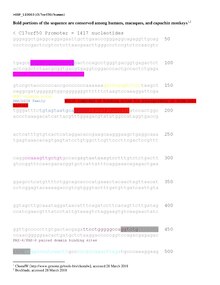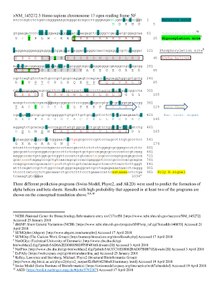| C17orf50 | |||||||||||||||||||||||||||||||||||||||||||||||||||
|---|---|---|---|---|---|---|---|---|---|---|---|---|---|---|---|---|---|---|---|---|---|---|---|---|---|---|---|---|---|---|---|---|---|---|---|---|---|---|---|---|---|---|---|---|---|---|---|---|---|---|---|
| Identifiers | |||||||||||||||||||||||||||||||||||||||||||||||||||
| Aliases | C17orf50, chromosome 17 open reading frame 50, cholesin | ||||||||||||||||||||||||||||||||||||||||||||||||||
| External IDs | MGI: 1913580; HomoloGene: 11949; GeneCards: C17orf50; OMA:C17orf50 - orthologs | ||||||||||||||||||||||||||||||||||||||||||||||||||
| |||||||||||||||||||||||||||||||||||||||||||||||||||
| |||||||||||||||||||||||||||||||||||||||||||||||||||
| |||||||||||||||||||||||||||||||||||||||||||||||||||
| |||||||||||||||||||||||||||||||||||||||||||||||||||
| Wikidata | |||||||||||||||||||||||||||||||||||||||||||||||||||
| |||||||||||||||||||||||||||||||||||||||||||||||||||
Uncharacterized protein C17orf50 is a protein which in humans is encoded by the C17orf50 gene.
Gene
The gene is located on the long arm of chromosome 17 on the forward strand at position 17q12. C17orf50 spans 4,200 base pairs from 35,760,897 to 35,765,079. In humans, this gene encodes a protein that is 174 amino acids in length and has three exons.
Regulation of transcription
The promoter region for C17orf50 is 1417 base pairs long with an accession number of GXP_123003 from Genomatix. The first half of the promoter is poorly conserved even among primates.
There are many binding sites for transcription factors found in the brain and embryonic tissue, particularly Brn-5 POU domain factor, which has three binding sites within the conserved region of the promoter. This transcription factor is expressed in layer IV of the neocortex of adults and at its highest levels in the developing brain and spinal cord.

Homology/evolution
Orthologs of this gene exist in eukaryotes, predominantly in mammals. However, some homologs are present in birds, reptiles, and amphibians. There are no paralogs of this gene. The table below shows a short list of orthologs to trace the evolutionary history of C17orf50.
| Species | Accession number | Divergence from humans (MYA) | Identity |
|---|---|---|---|
| Homo sapiens | NP_660315 | 0 | 100% |
| Chlorocebus sabaeus | XP_008009267 | 29.44 | 85% |
| Mus musculus | NP_079768.2 | 90 | 68% |
| Pteropus vampyrus | XP_011385558 | 171 | 70% |
| Chelonia mydas | EMP28888 | 312 | 45% |
| Corvus brachyrhynchos | XP_017584321 | 312 | 44% |
| Anolis carolinensis | XP_003218353 | 312 | 37% |
| Xenopus tropicalis | OCA35560 | 352 | 46% |
The most distant ortholog found diverged from humans approximately 352 million years ago, indicating that the protein arose shortly before that. When compared to other proteins, namely cytochrome c and fibrinogen alpha chain, uncharacterized protein C17orf50 is a rapidly evolving protein.
Expression
C17orf50 is expressed at low levels in various tissues, such as lung, prostate, thymus, thyroid, trachea, small intestine, and stomach, and it is most highly expressed in the fetal brain.
Protein
The unmodified molecular weight of C17orf50 protein is 19.3 kilodaltons. The protein has a negative charge cluster from position 21 to 52; this is a glutamate-rich region. There are three nuclear localization signals with no other retention signals, strongly indicating that the protein is localized to the nucleus.
Characterization of the protein has shown binding to GPR146. Based on a proposed role in regulation of serum cholesterol levels in response to dietary cholesterol intake, the protein has been called cholesin.
Domains
Uncharacterized protein C17orf50 contains a domain of unknown function (DUF4673) from position 5 to 172, which makes up the majority of the protein.
Post-translational modifications
Uncharacterized protein C17orf50 contains two potential sumoylation sites at K7 and K12. There are possible threonine and serine glycosylation sites throughout the protein. Potential threonine, serine, and tyrosine phosphorylation sites are also present.

Interacting proteins
The protein product also called cholesin binds to GPR146. Uncharacterized protein C17orf50 has potential interactions with zinc finger protein 587(ZNF587), which is expressed throughout fetal tissue, including the brain, ZNF587 is expected to regulate transcription.
References
- ^ GRCh38: Ensembl release 89: ENSG00000270806 – Ensembl, May 2017
- ^ GRCm38: Ensembl release 89: ENSMUSG00000035085 – Ensembl, May 2017
- "Human PubMed Reference:". National Center for Biotechnology Information, U.S. National Library of Medicine.
- "Mouse PubMed Reference:". National Center for Biotechnology Information, U.S. National Library of Medicine.
- "Gene: C17orf50 ENSG00000270806". Ensembl. EMBL-EBI. Retrieved 6 May 2018.
- "uncharacterized protein C17orf50 [Homo sapiens]". NCBI. US National Library of Medicine. Retrieved 25 January 2018.
- ^ "C17orf50 chromosome 17 open reading frame 50 [ Homo sapiens (human) ]". NCBI. US National Library of Medicine. Retrieved 25 January 2018.
- ^ "GXP_123003". Genomatix. Archived from the original on 24 February 2001. Retrieved 26 March 2018.
- ^ "NCBI". US National Library of Medicine. Retrieved 19 February 2018.
- "Multiple Sequence Alignment". ClustalW. Kyoto University Bioinformatics Center. Retrieved 28 March 2018.
- "BoxShade Server". ExPASy. Swiss Institute of Bioinformatics. Archived from the original on 29 October 2020. Retrieved 28 March 2018.
- Andersen B, Schonemann MD, Pearse RV, Jenne K, Sugarman J, Rosenfeld MG (November 1993). "Brn-5 is a divergent POU domain factor highly expressed in layer IV of the neocortex". The Journal of Biological Chemistry. 268 (31): 23390–8. doi:10.1016/S0021-9258(19)49475-1. PMID 7901208.
- "TimeTree". The Timescale of Life. Institute for Genomics and Evolutionary Medicine. Retrieved 22 February 2018.
- "Chromosome 17 open reading frame 50". UniGene. NCBI. Retrieved 28 March 2018.
- "Results for job saps-I20180327-142242-0812-44488260-p1m". EMBL-EBI. European Molecular Biology Laboratory. Retrieved 17 April 2018.
- "PSORTII". PSORTII. Retrieved 17 April 2018.
- ^ Hu X, Chen F, Jia L, Long A, Peng Y, Li X; et al. (2024). "A gut-derived hormone regulates cholesterol metabolism". Cell. 187 (7): 1685-1700.e18. doi:10.1016/j.cell.2024.02.024. PMID 38503280.
{{cite journal}}: CS1 maint: multiple names: authors list (link) - "SUMOplot Analysis Program". Abgent. WuXi AppTec. Retrieved 17 April 2018.
- "GPS-SUMO Online Service". GPS. The Cuckoo Workgroup. Archived from the original on 6 May 2018. Retrieved 17 April 2018.
- "NetOGlyc 4.0 Server". DTU Bioinformatics. Department of Bio and Health Informatics. Retrieved 3 April 2018.
- "NetPhos 3.1 Server". DTU Bioinformatics. Department of Health and Bioinformatics. Retrieved 3 April 2018.
- "IntAct". EMBL-EBI. European Molecular Biology Laboratory. Retrieved 19 April 2018.
- "Uniprot". UniProt. UniProt Consortium. Retrieved 19 April 2018.
- "ensg00000198466 (ZNF587) Homo sapiens zinc finger protein 587". Expression Atlas. EMBL-EBI. Retrieved 25 April 2018.
- "UniProtKB - Q96SQ5 (ZN587_HUMAN)". UniProt. UniProt Consortium. Retrieved 25 April 2018.




